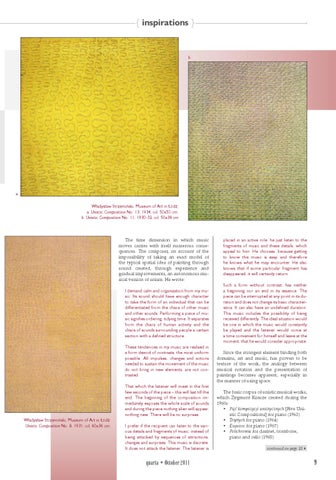{ inspirations }
b.
a. Władysław Strzemiński, Museum of Art in Łódź: a. Unistic Composition No. 13, 1934, oil, 50x50 cm; b. Unistic Composition No. 11, 1930-32, oil, 50x38 cm
The time dimension in which music moves carries with itself numerous consequences. The composer, on account of the impossibility of taking an exact model of the typical spatial idea of painting through sound created, through experience and gradual improvements, an autonomous musical version of unism. He wrote: I demand calm and organization from my music. Its sound should have enough character to take the form of an individual that can be differentiated from the chaos of other music and other sounds. Performing a piece of music signifies ordering, tidying time. It separates from the chaos of human activity and the chaos of sounds surrounding people a certain section with a defined structure. These tendencies in my music are realised in a form devoid of contrasts, the most uniform possible. All impulses, changes and actions needed to sustain the movement of the music do not bring in new elements, are not contrasted. That which the listener will meet in the first few seconds of the piece – this will last till the end. The beginning of the composition immediately exposes the whole scale of sounds and during the piece nothing alien will appear, nothing new. There will be no surprises. Władysław Strzemiński, Museum of Art in Łódź: Unistic Composition No. 8, 1931, oil, 60x36 cm;
I prefer if the recipient can listen to the various details and fragments of music, instead of being attacked by sequences of attractions, changes and surprises. This music is discrete. It does not attack the listener. The listener is
quarta • October 2011
placed in an active role: he just listen to the fragments of music and these details, which appeal to him. He chooses, because getting to know this music is easy, and therefore he knows what he may encounter. He also knows that if some particular fragment has disappeared, it will certainly return. Such a form without contrast, has neither a beginning nor an end in its essence. The piece can be interrupted at any point in its duration and does not change its basic characteristics. It can also have an undefined duration. This music includes the possibility of being received differently. The ideal situation would be one in which the music would constantly be played and the listener would come at a time convenient for himself and leave at the moment, that he would consider appropriate. Since the strongest element binding both domains, art and music, has proven to be texture of the work, the analogy between musical notation and the presentation of paintings becomes apparent, especially in the manner of using space. The basic corpus of unistic musical works, which Zygmunt Krauze created during the 1960s: • Pięć kompozycji unistycznych [Five Unistic Compositions] for piano (1963) • Triptych for piano (1964) • Esquisse for piano (1967) • Polichromia for clarinet, trombone, piano and cello (1968) continued on page 10
9
